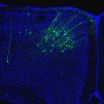(Press-News.org) Recalling an emotional experience, even years later, can bring back the same intense feelings. Researchers from the RIKEN-MIT Center for Neural Circuit Genetics revealed the brain pathway that links external events to the internal emotional state, forming one memory by engaging different brain areas. The study published in the journal Nature, also demonstrates that the positive or negative emotional valence of memory can be reversed during later memory recall.
The research team, led by Dr. Susumu Tonegawa, was interested in how brain structures like the hippocampus and the amygdala collaborate to form memories. In particular, they wanted to know whether the emotional valence--which describes the attractiveness or averseness of an emotion as positive or negative, and is thought of as an internal state of a person--is stored in the same place in the brain as the memory of an event that caused the emotion.
"Both the hippocampus and the amygdala are considered critical for memory formation. We wanted to know whether the memory engram was free to associate with positive or negative valences or whether it was fixed with respect to emotion," said Roger Redondo, who along with Joshua Kim is co-first author of this study. "We also wanted to know at what point in the circuit the valence is assigned to the engram, in the hippocampus or the amygdala."
In the experiment, mice were placed in a novel chamber and some were given a mild foot shock, while others were allowed to socialize with a female mouse, forming either a fear or a rewarding memory. The researchers were able to genetically label neurons that were active during the formation of either memory. The same neurons were then activated using optogenetics--a technique that harnesses light-sensing machinery from microbial organisms to precisely control activity of specific brain cells using pulses of light. Depending on the valence of the initial experience, the researchers could judge from the mouse's behavior whether the activated memory was a fearful or a rewarding one by whether the mice avoided or were attracted to a particular location in the chamber where the memory neurons were optogenetically activated.
"If our technology drives memory engrams, it should work independently of whether the valence is negative or positive," explained Dr. Redondo. "We wanted to show that the memory reactivation was not restricted to fear memories, as we had used in the past."
To address the question of where in the brain the memory of an event and its emotional valence are stored, the researchers attempted to switch the valence of memories in mice from negative to positive and vice versa. The mice were given a new experience of the opposite valence while the researchers simultaneously activated the original memory in either the hippocampus or the amygdala. As a result, the memory engram stored in the hippocampus could change its valence. Mice who originally received foot shocks no longer showed fear when recalling that experience. Conversely, mice that originally socialized with a female now showed fear. The valence of the memory engram in the amygdala, on the other hand, could not be altered.
The researchers concluded that the hippocampal memory was neutral and could freely associate with either positive or negative emotions, while the amygdala is hard-wired for either negative or positive experiences. This study reveals an unanticipated flexibility in brain circuits during memory formation for emotional events. The findings may help explain the success of behavioral therapy for people with phobias or PTSD, and suggests the possibility of developing novel treatments for these and other disorders affecting emotions, such as depression, through manipulation of hippocampal memory cells.
INFORMATION:
Researchers switch emotion linked to memory
2014-08-27
ELSE PRESS RELEASES FROM THIS DATE:
Breaking benzene
2014-08-27
Aromatic compounds are found widely in natural resources such as petroleum and biomass, and breaking the carbon?carbon bonds in these compounds plays an important role in the production of fuels and valuable chemicals from natural resources. However, aromatic carbon-carbon bonds are very stable and difficult to break. In the chemical industry, the cleavage of these bonds requires the use of solid catalysts at high temperatures, usually giving rise to a mixture of products, and the mechanisms are still poorly understood.
Now, in research published in Nature, Zhaomin Hou ...
Walking fish reveal how our ancestors evolved onto land
2014-08-27
VIDEO:
Polypterus senegalus walks across a sandy substrate. Fish use their fins and body in combination to move across a terrestrial substrate. Fins are planted one after the other to lift...
Click here for more information.
About 400 million years ago a group of fish began exploring land and evolved into tetrapods – today's amphibians, reptiles, birds, and mammals. But just how these ancient fish used their fishy bodies and fins in a terrestrial environment and what evolutionary ...
NIH issues finalized policy on genomic data sharing
2014-08-27
The National Institutes of Health has issued a final NIH Genomic Data Sharing (GDS) policy to promote data sharing as a way to speed the translation of data into knowledge, products and procedures that improve health while protecting the privacy of research participants. The final policy was posted in the Federal Register Aug. 26, 2014 and published in the NIH Guide for Grants and Contracts Aug. 27, 2014.
Starting with funding applications submitted for a Jan. 25, 2015, receipt date, the policy will apply to all NIH-funded, large-scale human and non-human projects that ...
Scientists looking across human, fly and worm genomes find shared biology
2014-08-27
Researchers analyzing human, fly, and worm genomes have found that these species have a number of key genomic processes in common, reflecting their shared ancestry. The findings, appearing Aug. 28, 2014, in the journal Nature, offer insights into embryonic development, gene regulation and other biological processes vital to understanding human biology and disease.
The studies highlight the data generated by the modENCODE Project and the ENCODE Project, both supported by the National Human Genome Research Institute (NHGRI), part of the National Institutes of Health. ...
Worms, flies and humans... Our common genomic legacy, key to understanding cell biology
2014-08-27
This news release is available in Spanish. Genomes accumulate changes and mutations throughout evolution. These changes have resulted in a huge diversity of species and in different traits between us. But animal cells, whether they are from a fly or a human, work similarly: they have common molecular mechanisms.
Based on this premise, an international consortium with participation of scientists from the Centre for Genomic Regulation in Barcelona have compared the transcriptome (the RNA complement of a species' cell) of different animal species. They used data from ...
Snowfall in a warmer world
2014-08-27
If ever there were a silver lining to global warming, it might be the prospect of milder winters. After all, it stands to reason that a warmer climate would generate less snow.
But a new MIT study suggests that you shouldn't put your shovels away just yet. While most areas in the Northern Hemisphere will likely experience less snowfall throughout a season, the study concludes that extreme snow events will still occur, even in a future with significant warming. That means that, for example, places like Boston may see less snowy winters overall, punctuated in some years ...
Researchers change the emotional association of memories
2014-08-27
By manipulating neural circuits in the brain of mice, scientists have altered the emotional associations of specific memories. The research, led by Howard Hughes Medical Institute investigator Susumu Tonegawa at the Massachusetts Institute of Technology (MIT), reveals that the connections between the part of the brain that stores contextual information about an experience and the part of the brain that stores the emotional memory of that experience are malleable.
Altering those connections can transform a negative memory into a positive one, Tonegawa and his MIT colleagues ...
Witnessing the early growth of a giant
2014-08-27
Elliptical galaxies are large, gas-poor gatherings of older stars and are one of the main types of galaxy along with their spiral and lenticular relatives. Galaxy formation theories suggest that giant elliptical galaxies form from the inside out, with a large core marking the very first stages of formation.
However, evidence of this early construction phase has eluded astronomers — until now.
Astronomers have now spotted a compact galactic core known as GOODS-N-774, and nicknamed Sparky [1]. It is seen as it appeared eleven billion years ago, just three billion years ...
Stop and listen: Study shows how movement affects hearing
2014-08-27
DURHAM, N.C. -- When we want to listen carefully to someone, the first thing we do is stop talking. The second thing we do is stop moving altogether. This strategy helps us hear better by preventing unwanted sounds generated by our own movements.
This interplay between movement and hearing also has a counterpart deep in the brain. Indeed, indirect evidence has long suggested that the brain's motor cortex, which controls movement, somehow influences the auditory cortex, which gives rise to our conscious perception of sound.
A new Duke study, appearing online August 27 ...
NASA sees massive Marie close enough to affect southern California coast
2014-08-27
Two NASA satellites captured visible and infrared pictures that show the massive size of Hurricane Marie. Marie is so large that it is bringing rough surf to the southern coast of California while almost nine hundred miles west of Baja California.
On August 26 at 19:05 UTC (3:05 p.m. EDT) NASA's Terra satellite captured a visible image of Hurricane Marie drawing in the small remnants of Karina. Marie is over 400 miles in diameter, about the distance from Washington, D.C. to Boston, Massachusetts. Hurricane force winds extend outward up to 60 miles (95 km) from the center ...



